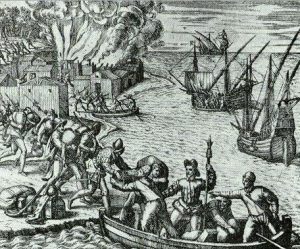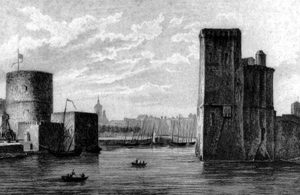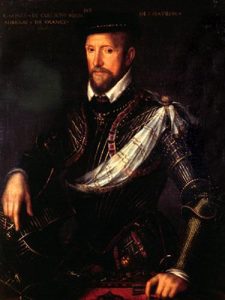British and French pirates
The treaty of Tordesillas on the 7th of June 1494 declared that lands lying beyond the Atlantic Ocean, whether discovered in the past or the future, were to be shared uniquely between Spain and Portugal. In addition, Pope Alexander VI gave his approval in a papal bull. This treaty did not receive the agreement of France or England and they were all the more offended by it because soon after this, the Spanish refused to allow any other nation to tradewith their American colonies.
It was in such circumstances as this that both France and England allowed their corsairs to attack Spanish vessels in Europe and the West Indies, with the justification that they had letters giving official permission from their government, although these papers were sometimes false. Indeed, sometimes the politicians actively encouraged such ventures.
Huguenots and the war of privateers
In 1521, French privateers began a series of attacks of Spanish vessels returning from the West Indies.
Huguenot ship-owners, among others, became heavily involved in privateering, soon to be joined by their Anglican counterparts on the other side of the Channel. Their reasons for doing so were probably mercenary, but also and especially religious : we must remember that this was the period of the religious wars. What the Spanish really feared was that the French Huguenots should also form colonies in « their » territory in the New World. Indeed, in 1565, under the orders of Pedro Menendez de Aviles, they had already destroyed the colony in Florida which had been founded by J.Ribault and René de Laudonière : they had slaughtered all the inhabitants « not because they were French but because they were Lutherans. » Similarly, when they captured corsairs, the Spanish would treat them as heretics rather than ordinary prisoners : this is why they were sent to the gallows, the punishment normally allotted to such a crime in Spain.
Seafarers lived a life of great freedom : this is one of the reasons why they soon joined the Reform Movement. In fact, there were so many of them that Jean le Frère said in 1584 that « nearly all seafaring men in France were protestant, especially those who came from Normandy, the most expert of them all. »
Admiral Coligny was the main organiser of the privateering war, which can be seen from two aspects :
- the first aspect concerned the wars between Spain and France : Protestants became involved in the founding of colonies and sought to bring down Spain by attacking her vessels.
- the other aspect concerned the financing of the « Protestant cause » during the religious wars in France, led by Jeanne d’Albret and the Protestant princes.
Well-known protestant corsairs
In 1523, Jean Forin (or Fleury), captain of the corsair fleet belonging to the ship-owner in Dieppe Jean Ango, captured a Spanish galleon containing « MOCTEZUMA’S treasure », which Cortez was sending to Charle Quint. This was at quite a distance from the Cape St. Vincent. Later, Guillaume Chaudet, son of a wealthy protestant merchant in Honfleur, « relieved » a vessel coming from the Canary Islands (or from Porto Rico) of a rich cargo of sugar.
In the West Indies, the corsairs attacked not only vessels carrying rich cargoes, but also Spanish towns situated on the coast or on the islands. Between 1536 and 1568, 152 ships were captured in the Caribbean and 37 between Spain, the Canary Islands and the Azores (although not all of them by Huguenots). It is interesting to note that the corsairs carried smuggled goods on their ships which were later sold to the inhabitants of the Spanish towns in the West Indies, shortly to be followed by more attacks on Spanish vessels !
Amongst the towns which were attacked, we can mention the following : in 1543, Carthaginia (Colombia), by a joint force of 300 French and English corsairs. In 1534, Santiago de Cuba was ransacked by Jacques de Sores, using 3 boats and 300 men. He did the same the following year in Santa Maria (Cuba). In July, in the company of the Norman François de Clerc, he seized Havana, where he burned the churches and seized an enormous booty. François de Clerc had been given the first official privateer’s licence, allowing him to capture vessels in America.
In 1573 (or 1572) another Huguenot, Guillaume Le Testut, a corsair who was a member of the Dieppe school of cartography, joined forces with the famous English captain Francis Drake. The two of them, with their men, attacked a large convoy bringing gold and silver from Peru, after having put out of action a strong Spanish escort. This was near the port of Nombre de Dios on the isthmus of Panama. Sadly, Guillaume Le Testut was killed in action.
Privateering vessels
The Huguenots used boats with a rounded bow, as opposed to the galleys. They had 2 or 3 masts and were straightforward boats used for transporting goods or as long distance fishing vessels – they had only been transformed into warships by the privateers. They were often called fishing boats and were usually about 6 to 100 tonnes. They could capture ships which were much larger than themselves, such as the two imposing Venetian vessels (« caraques ») which Jacques de Sores seized in 1569 off the English coast, estimated at 800 or 900 tonnes. They were fitted out for war with fairly light artillery cannons made of bronze or cast iron. This was because the captured cargo was often very heavy and was not to be divided into separate loads. If the corsairs’ boats themselves had been too heavy, they would have sunk beneath the weight of the stolen goods. So it was men, rather than artillery, who gave every corsair boat its lethal power.
Home ports
In France, Huguenot corsairs belonged mainly to ship-owners living in Dieppe and La Rochelle, but there were also some in the Seudre estuary (Marennes, Arvert, La Tremblade). The sailors from these ports formed an enormous military base which provided an endless supply of corsairs. Strangely enough, the very same ship-owners, captains and boats which were involved in cod fishing in peace time, would, in times of war, be suddenly transformed and take part in privateering attacks on Spanish vessels and colonies. Le Havre, too, from 1562 onwards, during its occupation by the English, was an important base for privateering ships, which set out from there to attack Catholic vessels in the Channel nearby.
The corsairs’ territory on the French coast extended from Calais down to Spain and Portugal and even as far as the Azores and the Barbary states. In 1574 there were sixty privateering ships and fishing boats fitted out for war sailing in these waters. Many of the captains were Norman, coming from such ports as Fécamp, Dieppe and Yport who were grouped together at La Rochelle. This is where the « local » privateers embarked, unloading and negotiating their prizes captured at sea ; other privateers also came to this port with their captured vessels – 29 Spanish and Flemish ships were brought here in 1570 and 34 in 1571. Other ports such as Aunis and Saintonge also received privateers with their prizes.
La Rochelle was also the base for activities of the Dutch corsairs (zélandais) in the service of the prince of Orange, called the « Sea Beggars ». William of Nassau was even there himself between 1571 and 1572. He greatly appreciated the French Protestant corsairs because they attacked Spanish vessels, thus depriving Philip II of the wealth coming from the New World ; this meant that the duke of Albi was not so well placed financially in his repression of the revolt in the Netherlands. These corsairs also intercepted food and ammunition destined for Spanish troops.
Financial aspects of privateering
During the religious wars, La Rochelle became a place of retreat for the protestant armies – it soon became necessary to maintain a permanent military fleet and the corsairs were not only used to fight against the Spanish but also to bring back supplies to guarantee the survival of the armies based in la Rochelle and also to contribute to the finances of « the (Protestant) cause ». Letters with an official stamp were given to the corsairs in the name of Jeanne d’Albret and the protestant princes. Coligny himself sometimes organized expeditions which he financed – in exchange, he received large sums of prize money. These letters had the advantage for the corsairs of making their military actions official and legal. They were supposed to protect them from being taken to court. The corsairs were enrolled in a « Sea Army » under the command of Sieur de la Tour, who was replaced after his death in Jarnac by Jacques de Sores.
When the contents of the prize ships were put up for sale, one tenth of all regular goods was reserved for « the Admiral », that is to say, Henri de Navarre who also held the title of admiral. Another « tenth » was later reserved for « the Cause ». The money thus put on one side became a key source of income for the protestant party.




